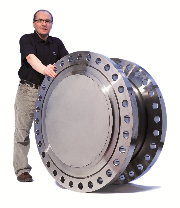 HBM’s series of free on-line webinars continue in April by examining the role that torque transducers can play in optimizing the performance of ship’s engines as well as looking at the importance of determining strain gauge excitation voltage.
HBM’s series of free on-line webinars continue in April by examining the role that torque transducers can play in optimizing the performance of ship’s engines as well as looking at the importance of determining strain gauge excitation voltage.
The first webinar happens on 8th April and looks at how integrating torque transducers in ship’s drives can optimize the propulsion economy and protect the environment. Participants will learn how to monitor the load distribution within a ship’s drive system using torque sensor technology. They will also discover why the efficiency of a ship’s engines demands exact measured values for optimum load distribution.
Klaus Weissbrodt, who has been developing high-capacity torque measurement solutions for the marine industry over the past several years, presents the webinar and includes the important steps that need to be taken when integrating torque sensors in a marine propulsion system.
This webinar is particularly relevant with the incremental reduction on the limits of emissions of nitrogen and sulphur oxides demanded by the international MARPOL Convention through to 2016 to protect marine environments. Precisely measuring the drive power optimises emission output even with recent developments in marine propulsion units.
The efficiency of a ship’s drive can be generally characterized by low fuel consumption, minimal exhaust gas values and an output power adapted to voyage conditions. To keep drive power within the optimal working range, even with rapid load changes, all these parameters must be measured with the highest possible accuracy. Load distribution over several drives, running in parallel, also requires exact measured values as a basis for monitoring and control.
A second webinar takes place on 22 April that looks at the importance of bridge excitation voltage. Many engineers remain unclear what this really means and how it can be determined although the maximum effective bridge excitation voltage is an important parameter in a strain gauge’s technical data sheet.
The seminar will also include a discussion on determining the most suitable strain gauge for any application and how engineers can easily optimize sensor configuration. A strain gauge’s maximum effective excitation voltage is specified on its packaging or its data sheet. It is essential to use the value matched to the measuring body material and complying with these values guarantees a minimum measurement error.
When strain is measured using strain gauges in a Wheatstone bridge the applied voltage results in a loss of power in the form of heat in the strain gauge’s measuring grid. This heat needs to be dissipated since excessive heat in the strain gauge will result in incorrect measured values.
Defining a maximum permissible effective bridge excitation voltage is essential since the heating of the strain gauge cannot be entirely avoided and this webinar looks at optimising the use of strain gauges.
Individuals wishing to register for these informative webinars can click here for details.
HBM
Founded in Germany in 1950, HBM is today the technology and market leader in the field of test and measurement. HBM’s product range comprises solutions for the entire measurement chain, from virtual to physical testing. The company has production facilities in Germany, USA and China and is represented in over 80 countries worldwide.
